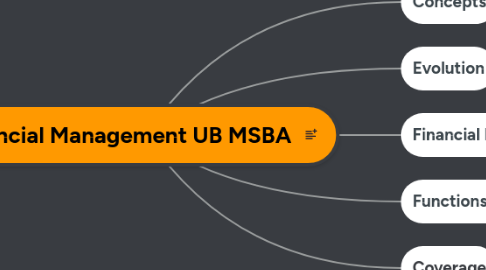
1. Concepts
1.1. Financing decisions
1.1.1. Assets Management
1.1.2. Acquiring funds (Debt &/or Equity)
1.1.2.1. Issue new stocks or not
1.1.2.2. Issue bonds or not
1.1.3. Using funds (Investment decisions)
1.1.3.1. Pay dividends or not
1.1.3.2. Replace an asset or not
1.1.3.3. Where to invest its money
1.2. Core principles
1.2.1. Time value of money
1.2.1.1. The opportunity to earn a return on invested funds means that a dollar today is worth more than a dollar in the future
1.2.2. Compensation for risk
1.2.2.1. Investors expect compensation for bearing risk
1.2.3. Don't put all your eggs in one basket
1.2.3.1. Investors can achieve a more favorable trade-off between risk and return by diversifying their portfolios
1.2.4. Markets are smart
1.2.4.1. Competition for information tends to make markets efficient
2. Evolution
2.1. 1900's
2.1.1. Separated from field of economics
2.2. 1930's
2.2.1. Preservation of capital
2.2.2. Maintenance of liquidity
2.2.3. Rehabilitation of financially troubled firms
2.2.4. Bankruptcy
2.3. 1950's
2.3.1. More analytical
2.3.2. Financial capital vs. Real capital
2.3.3. Cash & Inventory management
2.3.4. Capital structure theory
2.3.5. Dividend policy
2.4. 1980's
2.4.1. Risk-return relationships
2.4.2. Maximization of returns for a given level of risk
2.4.3. Portfolio management
2.4.4. Capital structure theory
2.4.5. New financial products focused on hedging
2.4.6. Effects of inflation on financial forecasting
2.4.7. Required rate for capital budgeting
2.4.8. Cost of Capital
2.5. Internet era
2.5.1. Enabled e-commerce solutions
2.5.1.1. For "old economy" existing companies
2.5.1.2. B2C: buying with credit cards
2.5.1.3. B2B: ordering, inventory, supply bidding } all online
2.5.2. Spurt new business models & companies
2.5.2.1. Amazon.com
2.5.2.2. Ebay
2.5.2.3. Apple.com
2.5.2.4. Facebook
3. Financial Markets
3.1. Participants
3.1.1. Public
3.1.1.1. Government reserves
3.1.1.2. Interest rates
3.1.1.3. Regulations
3.1.2. Corporate
3.1.2.1. Banks
3.1.2.2. Insurance companies
3.1.2.3. Credit unions
3.1.2.4. Mutual funds
3.2. Indicators
3.2.1. Maximization of shareholder value
3.2.2. Ethical behavior as value
3.3. Types
3.3.1. According to maturity
3.3.1.1. <12 months
3.3.1.1.1. Money market
3.3.1.2. >12 months
3.3.1.2.1. Long-term securities
3.3.2. According to primacy
3.3.2.1. Primary
3.3.2.1.1. Raising funds through sale of corporate securities through new issue
3.3.2.2. Secondary
3.3.2.2.1. Performance of corporate securities in the markets is an indicator of corporate performance
4. Functions of Financial Manager
4.1. Daily
4.1.1. Credit management
4.1.2. Inventory control
4.1.3. Receipt & disbursement of funds
4.2. Occasional
4.2.1. Stock issue
4.2.2. Bond issue
4.2.3. Capital budgeting
4.2.4. Dividend decision
4.3. Tradeoffs
4.3.1. Profitability vs. Risk
4.3.2. Influences
4.3.2.1. Operational side
4.3.2.2. Capital vs. Labor
4.3.2.3. Product A vs. Product B
4.3.2.4. Financial mix
4.3.2.4.1. Determine how the assets (LHS of balance sheet) will be financed (RHS of balance sheet)
4.3.2.4.2. Stocks vs. Bonds vs. Retained earnings
4.3.2.5. Business form
4.3.2.5.1. Single proprietorship
4.3.2.5.2. Partnership
4.3.2.5.3. Corporation
4.4. Goals
4.4.1. Establish Right Valuation approach
4.4.2. Management & stockholder wealth
4.4.3. Maximize shareholders wealth
4.4.3.1. Maximize stock price, not profits or EPS
4.4.3.2. Why not profits or EPS?
4.4.3.2.1. Earnings per share are backward-looking, dependent on accounting principles
4.4.3.2.2. Do not fully consider cash flow timing
4.4.3.2.3. Ignores risk
4.4.4. Social responsibility
4.4.4.1. Attracts capital
4.4.4.2. Consequentially mandatory
4.4.4.3. Cost increasing activities
4.4.4.4. Initially voluntary
4.4.4.5. Offers benefits to society
4.4.4.6. Provides employment
5. Coverage
5.1. A. Overview of Corporate Finance
5.1.1. 1 Introduction to Corporate Finance
5.1.2. 2 Financial Statements, Taxes, and Cash Flow
5.2. B. Financial Statements and Long−Term Financial Planning
5.2.1. 3 Working with Financial Statements
5.2.2. 4 Long-Term Financial Planning and Growth
5.3. C. Valuation of Future Cash Flows
5.3.1. 5 Introduction to Valuation: The Time Value of Money
5.3.2. 6 Discounted Cash Flow Valuation
5.3.3. 7 Interest Rates and Bond Valuation
5.3.4. 8 Stock Valuation
5.4. D. Capital Budgeting
5.4.1. 9 Net Present Value and Other Investment Criteria
5.4.2. 10 Making Capital Investment Decisions
5.4.3. 11 Project Analysis and Evaluation
5.5. E. Risk and Return
5.5.1. 12 Some Lessons from Capital Market History
5.5.2. 13 Return, Risk, and the Security Market Line
5.5.3. 14 Options and Corporate Finance
5.6. F. Cost of Capital and Long−Term Financial Policy
5.6.1. 15 Cost of Capital
5.6.2. 16 Raising Capital
5.6.3. 17 Financial Leverage and Capital Structure Policy
5.6.4. 18 Dividends and Dividend Policy
5.7. G. Short−Term Financial Planning and Management
5.7.1. 19 Short-Term Finance and Planning
5.7.2. 20 Cash and Liquidity Management Balance
5.7.3. 21 Credit and Inventory Management
5.8. H. Short−Term Financial Planning and Management
5.8.1. 22 International Corporate Finance
5.8.2. 23 Risk Management: An Introduction to Financial Engineering
5.8.3. 24 Option Valuation
5.8.4. 25 Mergers and Acquisitions
5.8.5. 26 Leasing
